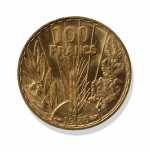1928
The franc germinal is replaced by the franc Poincaré in France
After World War I, the franc floated on the foreign exchange market and depreciated. This deterioration in the purchasing power of money was due to war and reconstruction expenses, the rise in public debt and the trade balance deficit. Thanks to the policy conducted by Raymond Poincaré, the franc stabilized on the foreign exchange market in 1926. A debate then took place between advocates of a revaluation of the franc to its pre-war level (franc germinal) and those in favor of a devaluation of the franc to its real value. In 1928, the Poincaré government chose to devalue the franc by 80%: the « franc Poincaré » was only worth a fifth of the gold equivalent of the franc germinal. A new law partially re-established the convertibility of banknotes into gold: this system was known as the « gold bullion standard » where gold bullion was sold at a fixed price in exchange for banknotes at the Banque de France.


